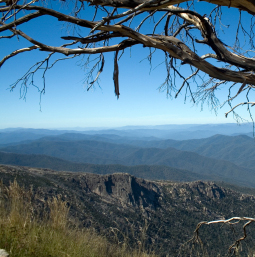National Parks Of The Victorian High Country

Alpine National Park
This is Victoria's largest park and covers most of the high country, protecting its highest mountains and varied alpine environments. The landscapes are some of the most rugged and beautiful countryside in the whole world. The park's extensive snowfields are the primary winter attraction; but during the warmer months there are stunning wildflower displays and opportunities for bushwalks and four wheel driving.
Over a thousand native plant species are found in the park, with many of these alpine species especially adapted to survive the severe winter climate. Twelve of these species are found nowhere else in the world. Mature alpine ash forests are common as you go up the mountains and snow gums are the dominant trees around the snowline. In the higher areas, where conditions are too severe for trees to survive, the vegetation changes to heathlands, alpine fields and snow patch vegetation. These High Plains are renowned for their spectacular summer wildflower displays. Of special note is the rare mountain pygmy-possum, the world's only exclusively alpine marsupial that stores food to last throughout the winter and is only found in a few places within the Victorian and NSW Alps.
Snowfall on the slopes of the Great Dividing Range in the winter months pulls in the ski tourists, who stay in the adjacent ski resorts of Falls Creek and Hotham. In the summer months, other adventure sports such as bushwalking, cycling and rock climbing become prevalent. Fishing in the King and the Rose Rivers is popular, where the brown trout grow thick and fast. A popular touring route is the Great Alpine Drive, which runs from Wangaratta to Bairnsdale. The 110km stretch between Bright and Omeo provides the greatest views of the park; just stop in at Danny Lookout and experience the views of the park and Mt Feathertop for yourself. You will feel like you are on the top of the world.
Lake Eildon National Park
On the shores of shining Lake Eildon, 150km northeast of Melbourne, lies the lushly forested Lake Eildon National Park. The park is easily accessed via the Goulburn Valley Highway, nestled into the northern foothills of the Central Highlands. The park itself is mountainous, with peaks up to 900m. It includes remnants of the Cerberean Caldera, a huge circular volcano around 27km across, which was active around 380 million years ago. There are plenty of designated nature trails and walking tracks that bring you into close contact with the wildlife and the beautiful landscapes of the park. The lake itself is perfect for water sports of all kinds and is used for skiing, boating, fishing and swimming. There are a number of campsites both near to the lake's edge as well as deeper in the park.
Mt Buffalo National Park
Established well over a century ago, Mt Buffalo National Park is one of Victoria's oldest National Parks. It protects Mt Buffalo and its surrounding landscapes. It lies just to the east of the town of Bright, which is reached by a 320km drive from Melbourne; you could base your campervan in Bright and explore the park from there. There is a beautiful place to stay in Bright, called Bright Holiday Park, perfect for campervans and right on the river.
There is a lot to see, from giant rock tors to 300m high cliffs, from sunlit alpine fields to light-dappled woodlands, from tiny creeks to foaming waterfalls. So, if you want to fully appreciate the park you will need to plan for more than a day trip. A must-see is the rock formation called the Cathedral, and throughout the park there are striking granite boulders. From the north, Mount Buffalo is quite remarkable, with the highest accessible point being a prominent peak called The Horn. A walking track leads to The Horn and visitors can enjoy a 360 degree view from the top. There are over 90km of walking tracks taking you to some of the most beautiful treasures of the park, and in the winter the snow attracts cross country skiers who utilise over 11km of demarcated trails. Hang gliding and abseiling off the high cliffs are also popular in the summer months, as is rock climbing.
Beechworth Historic Park
The town of Beechworth lies 280km northeast of Melbourne, just past Wangaratta. From 1852 - 1857, Beechworth was the centre of a fabulous gold rush region, and the local centre of government; but its power, wealth and influence were short lived. It is still, however, one of the most well preserved Gold Towns in Victoria, with over thirty of its buildings being heritage classified. These buildings are still in pristine condition, having been well maintained since as far back as the 1860s. The Beechworth Historic Park lies above and below the town and is home to a number of important old gold mining sites.
Creeks wind their way through thick eucalyptus and pine forests, and steep granite gullies mark the spots where miners once toiled away. A couple of the mining sites have been dammed to create lakes, Lake Sambell and Lake Kerferd, and a network of walking trails takes you past these attractions. Other walks connect to fascinating sites that tell the stories behind the search for gold: the Powder Magazine, the Spring Creek Cascades, The Precipice, Reids Creek Goldfields, Woolshed Falls, Ingrams Rock, and Fiddes Granite Quarry.
The fresh air and dramatic scenery of the high country is inspirational. Whatever the time of year, the Victorian Alps offer an abundance of photographic opportunities and are well worth a visit.

